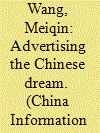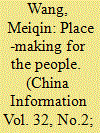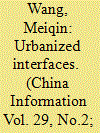|
|
|
Sort Order |
|
|
|
Items / Page
|
|
|
|
|
|
|
| Srl | Item |
| 1 |
ID:
140506


|
|
|
|
|
| Summary/Abstract |
Consumerism is a central feature of urbanism in China and has been actively promoted as a sign of urbanity in the official rhetoric and mass media. This urban ideology is exemplified by the ubiquitous presence of street advertisements that often occupy prominent urban public spaces. After all, turning every citizen of China into a consumer has become a widely accepted Chinese dream and one that is employed to mobilize a population otherwise divided by the ever-widening gap between the rich and poor. Advertisements have assumed a commanding role and are utilized by both official entities and private corporations to promote all kinds of urban consumption, ranging from concrete commodities such as high-end homes, beautiful neighbourhoods, and luxurious goods to intangible symbols such as lifestyle, ideology, and cosmopolitan identity. All these have fallen under the scrutiny of the Shanghainese artist Ni Weihua, whose photography documents billboards advertising official ideologies and real-estate projects in Shanghai and other cities. This study brings into context Ni’s artistic practice and examines specific ways in which his photographic series Keywords (关键词) and Landscape Wall (风景墙) engage with formal advertisements in the street both as an urban reality and as a site for deconstruction.
|
|
|
|
|
|
|
|
|
|
|
|
|
|
|
|
| 2 |
ID:
137203


|
|
|
|
|
| Summary/Abstract |
This article contextualises the art practice of Beijing-based artist Liu Bolin and examines ways in which his artworks illuminate the sociopolitical conditions that regulate the everyday reality of underprivileged social groups amid China’s spectacular urban transformation in the 2000s. The tension between individual existence and the force of urbanization underlays Liu’s most important work, entitled Hiding in the City. This performance photographic series, in which Liu covered his body thoroughly with paint so that he “disappeared” into the background, was initiated as a response towards the demolition of an artist village in Beijing where the artist resided and worked. The series has since been developed into an ambitious and years-long project in which the artist surveys the disparate urban living environment of the city, bringing to the surface dominant forces that render the existence of the individuals “invisible”
|
|
|
|
|
|
|
|
|
|
|
|
|
|
|
|
| 3 |
ID:
160503


|
|
|
|
|
| Summary/Abstract |
In the past decade, socially engaged artistic practices have become a growing trend in China, embraced not only by contemporary art circles but also by broad intellectual communities. In this article, I explore this under-studied trend by looking at the practices of a number of art professionals who engage themselves with place-making in different rural villages against the backdrop of a rapidly declining countryside which has resulted from China’s top–down, GDP-driven urbanization and social development. Mainstream place-making, led by government in collaboration with private developers, has been primarily concerned with a good business environment in order to attract the highly mobile elite class or realize a quick return from speculative development. Place-making led by art professionals, on the contrary, aims to revitalize the deprived countryside through art and cultural activities, foster the growth of place-specific civic spaces, and accentuate the participation of local, grass-roots populations as well as the collaboration of urban intellectuals from various backgrounds. I argue that the efforts of these art professionals not only provide critical reflections and bottom–up alternatives to the dominant social developmental discourse, but also activate and expand the potential of art as an agent of social intervention, community building, and cultural change.
|
|
|
|
|
|
|
|
|
|
|
|
|
|
|
|
| 4 |
ID:
140504


|
|
|
|
|
| Summary/Abstract |
In the past two decades, unparalleled urbanization in cities across mainland China has deeply affected and transformed Chinese visual arts. Critical artistic and creative examinations of the interfaces between urbanization, society, culture, arts and people in Chinese cities have produced a great variety of new visual forms and agencies. In this introductory essay, we argue that the complexities of reciprocal relationship between urbanization and the visual arts deserve greater scholarly attention than they have been given so far, and we call for continuous and multiple-perspective research into the subject. The visual arts not only mirror the city but they actively participate in city-making processes. The investigation of artists, filmmakers and urbanites into the changing urban space in which they live has given birth to a post-socialist urban aesthetics, which, as Robin Visser proposes, functions as a new realm to envision, experience and assess the city. In doing so, it enables new forms of civic agencies to emerge. Visual art, as indicated by Yomi Braester in his study of Chinese films, interacts with political decisions and architectural plans, creating both material and ideological constructs of the cities. We maintain that the varied forms of visual arts and agencies discussed in this special issue not only reveal and interpret how the processes of globalization and urbanization are interrelated, but also participate in the reconstruction of sociospatial relationships and the reconceptualization of the city at local, national, and even global levels.
|
|
|
|
|
|
|
|
|
|
|
|
|
|
|
|
|
|
|
|
|